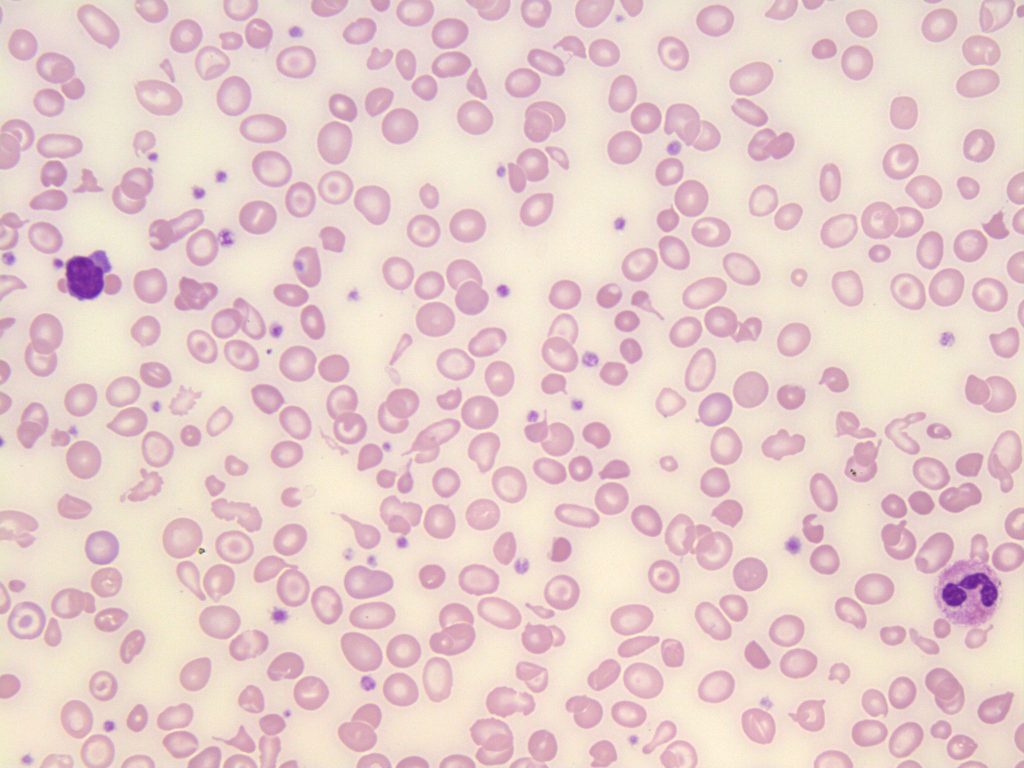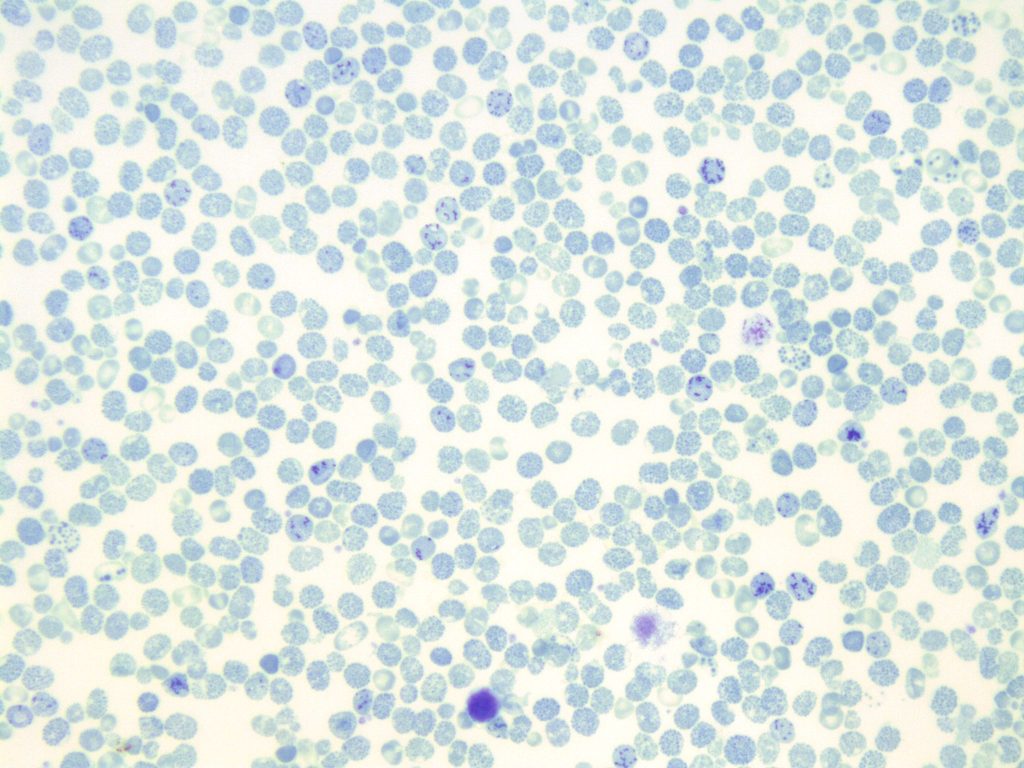33 Thalassemia
Michelle To and Valentin Villatoro
Images show thalassemia peripheral blood smears with hypochromic, microcytic red blood cells and poikilocytosis. From MLS Collection, University of Alberta.
Image 1: 50x oil immersion. https://doi.org/10.7939/R3DR2PQ4J
Image 2: 50x oil immersion. https://doi.org/10.7939/R3V698T05
Image 3: 50x oil immersion. https://doi.org/10.7939/R3HD7P773
Thalassemias are classified as a group of genetic hemoglobin disorders where the production of α and β globin chains is affected. This is considered to be a quantitative hemoglobin disorder and is categorized by the affected globin chain (alpha or beta), and as major or minor depending on the severity of the disease.1,2
Alpha-Thalassemia:
Cause(s):
α globin chain genes are located on chromosome 16 and there are normally four genes in total (αα/αα), two inherited from each parent. α-thalassemia results when there is a deletion in any number of the α globin gene. The severity of anemia and amount of α globin chain production is dependent the number of genes that are deleted.3
α-Thalassemia Silent Carrier (αα/α-):1,2
Occurs when one α gene is deleted. There is still adequate production of α to ensure normal hemoglobin synthesis. Patient is asymptomatic and the mutation is benign.
In newborns, there is an excess production of γ globin chains. These γ globin chains tend to also form tetramers and result in Hemoglobin Barts (Hb Barts). Hb Barts has a high oxygen affinity and is inefficient for oxygen delivery to the tissues of the developing fetus. In the silent carrier state, there is only a small amount of Hb Barts produced.
α-Thalassemia Minor (αα/–) or (α-/α-):1,2
Occurs when two α genes are deleted. There is now a 50% reduction in normal α globin chain production.
In adults, increased production of red blood cells is able to compensate for the decrease in α chain production, and α and β globin chain production is balanced. Patients are asymptomatic and any anemia present is mild.
There is between 5-15% hemoglobin Barts present at birth, but this decreases once β globin chain production takes over and γ globin chain production decreases. In adults, globin chain production is balances, so no Hemoglobin H is formed.
Hemoglobin H Disease (α-/–):1,2
- An image of a Hemoglobin H Disease peripheral blood smear showing marked poikilocytosis (tearsdrop cells, schistocytes, target cells, and elliptocytes). 50x oil immersion. From MLS Collection, University of Alberta, https://doi.org/10.7939/R30P0X613
- A supravital stained Hemoglobin H Disease peripheral blood smear. Hemoglobin H inclusions are seen in the red blood cells (Golf-ball like). 50x oil immersion. From MLS Collection, University of Alberta, https://doi.org/10.7939/R3BV7BB0V
Occurs when three α genes are deleted. α gene production is significantly reduced (75% reduction) causing a higher imbalance between the number of α and β globin chains being produced. Patients present with a chronic hemolytic anemia that varies from mild to moderate. Patients are transfusion- independent.
The excess β globin chains form tetramers known as Hemoglobin H (Hb H). Hb H is unstable and often precipitates within red blood cells resulting in hemolytic anemia. Production of Hb Barts at birth is increased.
Hydrops Fetalis/ α-Thalassemia Major (–/–):1
Occurs when all four α genes are deleted (no α globin chain production).
Because no sustainable amount of α globin chains is produced, this state is usually considered to be incompatible with life. Excess γ globin chains result in the formation of Hb Barts. Due to its high affinity for oxygen, it is not able to efficiently transport oxygen to the tissues of the developing fetus. The marked tissue hypoxia usually results in fetal death in utero or shortly after birth.
Table 1. Laboratory Findings of α-Thalassemias1
|
α-Thalassemia State |
CBC and RETIC |
PBS |
BM |
Hemoglobin Content |
|
α-Thalassemia Silent Carrier (αα/α-) |
Hb: Normal RBC: Normal MCV/MCH/MCHC: Normal RDW: Normal RETIC: Normal |
|
Normal |
Hb A: Normal Hb Barts: 1-3% at birth Hb H: 0% |
|
α-Thalassemia Minor (αα/–) or (α-/α-) |
Hb: Normal to Decreased RBC: Normal to Increased MCV/MCH/MCHC: Decreased RDW: Normal RETIC: Elevated |
|
Erythroid Hyperplasia |
Hb A: Slight decrease Hb Barts: 5-15% at birth Hb H: 0% |
|
Hemoglobin H Disease (α-/–) |
Hb: Decreased RBC: Increased MCV/MCH/MCHC: Decreased RDW: Normal to Increased RETIC: Elevated |
|
Erythroid Hyperplasia |
Hb A: Decreased Hb Barts: 10-40% at birth, traces in adults Hb H: 1-40% in adults |
|
Hydrops Fetalis/ α-Thalassemia Major (–/–) |
Hb: Decreased RBC: Decreased MCV/MCH/MCHC: Decreased RDW: Increased RETIC: Elevated |
|
Erythroid Hyperplasia |
Hb A: 0% Hb Barts: 80-90% Hb H: Not formed Absent: Hb A, Hb A2, Hb F |
Beta-Thalassemias
Cause(s):
β globin chain genes are located on chromosome 11 and there are normally two genes in total (β/β) one inherited from each parent. β-thalassemia is usually due to point mutations in the β globin genes. These point mutations cause production of β globin chains to be reduced (β+) or abolished completely (β0).3
β-Thalassemia Silent Carrier (βSilent/β):2
β globin chain genes mutation does not result in any abnormal hematological findings and β globin chain production is normal or nearly normal.
β-Thalassemia Minor (β0/β or β+/β):1,2
One β globin chain gene is mutated while the other β globin chain gene is normal. Patient is able to sufficiently produce enough β globin chains to maintain normal oxygenation and red blood cell lifespan.
Patients are asymptomatic and have mild anemia that can worsen under conditions of stress.
β-Thalassemia Intermedia (β+/βSilent or β0/βSilent or βSilent/βSilent):2
Mutations in the β genes result in reduced β globin chain production. Clinical symptoms are variable, and more severe than β-Thalassemia Minor, though patients do not require transfusions to survive.
β-Thalassemia Major (β+/β+ or β+/β0 or β0/β0):1,2
Mutations to both β genes results in severely decreased or absent production of β globin chains. Excess α globin chains are unable to form tetramers leading to their precipitation and accumulation in the red blood cell. This damages the cell and results in a chronic and severe hemolytic anemia.
Patients require regular transfusions.
Table 2. Laboratory Findings of β-Thalassemias2
| β-Thalassemia State | CBC and RETIC | PBS | BM | Hemoglobin Content |
| β-Thalassemia Silent Carrier
(βSilent/β) |
Hb: Normal RBC: Normal MCV/MCH/MCHC: Normal RDW: Normal RETIC: Normal |
N/A |
N/A |
Hb A: Normal Hb A2: Normal Hb F: Normal |
| β-Thalassemia Minor
(β0/β or β+/β) |
Hb: Decreased RBC: Normal to Increased MCV/MCH/MCHC: Decreased RDW: Normal RETIC: Normal to Increased |
|
Erythroid Hyperplasia
|
Hb A: 92-95% Hb A2: 3.5-7.0% Hb F: 1-5% |
| β-Thalassemia Intermedia
(β+/βSilent or β0/βSilent or βSilent/βSilent) |
Hb: Decreased RBC: Increased MCV/MCH/MCHC: Decreased RDW: Normal RETIC: Increased |
|
Erythroid Hyperplasia |
Hb A: Decreased Hb A2: Increased Hb F: Increased |
| β-Thalassemia Major
(β+/β+ or β+/β0 or β0/β0) |
Hb: Decreased RBC: Increased MCV/MCH/MCHC: Decreased RDW: Normal to Increased RETIC: Increased |
|
Erythroid Hyperplasia (Ineffective erythropoiesis) |
Hb A: Absent or decreased Hb A2: Variable Hb F: 70-90% |
Other Laboratory Tests to Assess Thalassemia:2
Iron Studies (Thalassemia Iron Studies are shown in the next chapter)
Hemoglobin Electrophoresis
High Performance Liquid Chromatography (HPLC)
Molecular testing for genetic mutations/deletions
Notes:
Above results are only typical findings, which may be altered depending on individual variation, treatment give (such as RBC transfusions), and genetic sub-type.
The peripheral blood smear picture for the minor forms of Thalassemia look very similar to that of Iron Deficiency Anemia. The difference between the two conditions can be distinguished by comparing iron study results, as well as specific CBC findings (RDW, RBC count), and peripheral smear findings (inclusions, poikilocytosis).2
References:
1. Randolph TR. Thalassemia. In: Clinical laboratory hematology. 3rd ed. New Jersey: Pearson; 2015. p. 251-276.
2. Keohane EM. Thalassemias. In: Rodak’s hematology clinical applications and principles. 5th ed. St. Louis, Missouri: Saunders; 2015. p. 454-74.
3. Chonat S, Quinn CT. Current standards of care and long term outcomes for thalassemia and sickle cell disease. Adv Exp Med Biol [Internet]. 2017 [cited 2018 Jun 5];1013:59–87. Available from: http://www.ncbi.nlm.nih.gov/pmc/articles/PMC5720159/



